Characteristics of the disease
Osteochondrosis is generally a degenerative modification of the intervertebral disc cartilage, which in turn affects the bone tissue and the nervous system. What happens to this disease? In the cartilage disk, which performs the function of absorbing vibrations in the structure of the spine, dehydration or simply dehydration, begins due to metabolic failure. The nucleus begins to press on the ring that surrounds it and the disc extends beyond the vertebrae. This phenomenon is called protrusion. If the membrane breaks, then an intervertebral hernia appears, which is even more dangerous.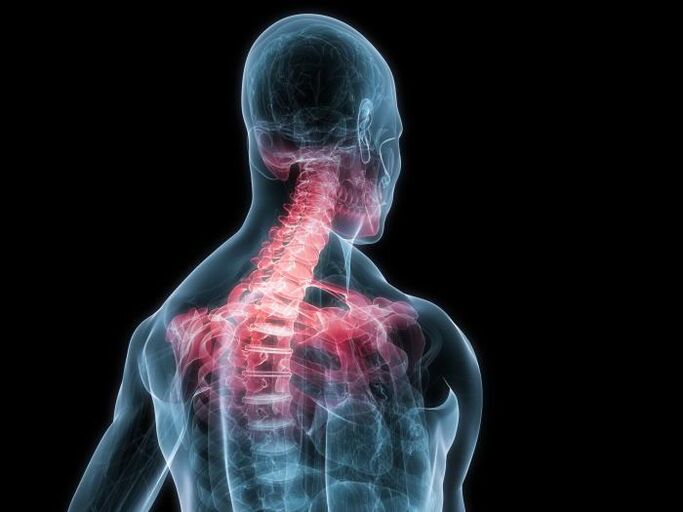
Osteochondrosis of the cervical spine is a disease that brings a lot of pain and discomfort into a person's life. Unlike the thoracic and lumbar vertebrae, the cervical vertebrae are more mobile, smaller and constantly under the influence of stress. The disease most often affects these specific parts of the spine. A large number of nerves and blood branches are concentrated in the cervical spine. A significant large vertebral artery passes through here, transporting nutrients to the brain. The state of contraction of this vessel is dangerous from the development of ischemia of the spinal cord or brain, as well as from a stroke. If this artery and the nerve fibers that pass to the cervical spine are affected, then the person loses the precise coordination of movements, his hearing and vision are impaired, there is frequent dizziness and various neurological disorders, which will be discussed below.
Reasons
Osteochondrosis of the cervical spine occurs even at a young age. What causes the disease to develop? What causes the disease, even in people under 30 years of age? Osteochondrosis of the cervical spine, the treatment of which requires a lot of time and patience, results from two main factors:- hypotension or sedentary lifestyle.
- malnutrition
As a result, there is a violation of metabolism (metabolism) throughout the body, especially in the tissues of bones and cartilage, the level of salt in the blood increases and those who do not find a way out of the bloodstream, find "shelter"in the tissues of the kidneys, liver and cervix. An unbalanced diet leads to a lack of nutrients in the cartilage, resulting in the onset of pathological changes in the intervertebral discs. Osteochondrosis is particularly sensitive in people at risk.

Let us mention the factors, the presence of which increases the probability of the disease:
- heredity?
- age after 40 years.
- overweight?
- frequent hypothermia (it's not something they say "don't catch a cold in your throat! ")
- endocrine system dysfunction, metabolic disorder.
- spinal injuries?
- systemic lupus erythematosus?
- rheumatism?
- nature of the activity - drivers, clerks, cashiers, athletes, people doing hard physical work.
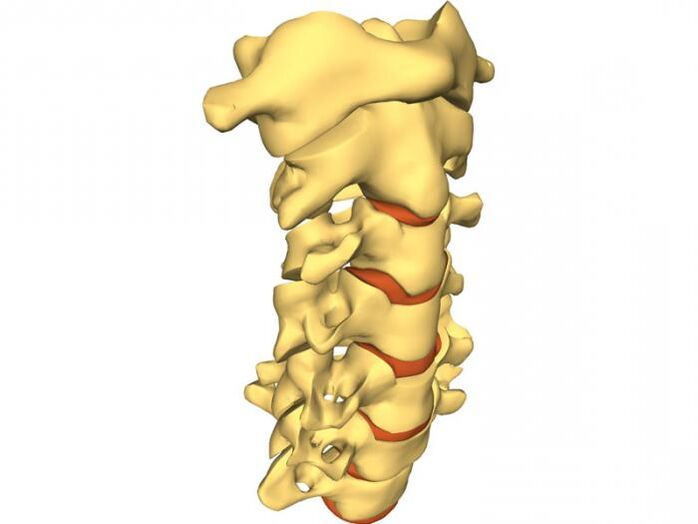
Symptoms
How does cervical osteochondrosis manifest? The symptoms of the disease and the nature of the pain that arise depend on which parts are damaged. In this case, the following situations may develop:
- spinal artery syndrome?
- hypertensive syndrome?
- root syndrome?
- cervical migraine syndrome.
Let's take a look at each of them. With vertebral artery syndrome, severe headaches appear already in the early stages. A person is often dizzy, gait becomes unstable and clarity of vision decreases. Sudden movements of the head can lead to loss of consciousness. The root syndrome is characterized by a variety of manifestations. These include:
- cervicitis or severe neck pain.
- crumpling when you turn your head?
- weakness and tinnitus?
- numbness and pain in the hand
- disturbance of auditory and visual functions.
- tinnitus?
- cervical pain or pain that spreads from the neck to the hands.
- feeling of swelling and numbness of the tongue.

Hypoxia (oxygen starvation) of the brain occurs. Osteochondrosis of the cervix is often manifested by cardiac arrhythmia, in which a uniform heart rhythm is lost. Due to the stinging of the lateral vertebral arteries, vegetative-vascular dystonia develops.
Diagnostics
The first step in diagnosing cervical osteochondrosis is to examine the patient. A neurologist visually examines the condition of the spine, back muscles and posture and determines the presence of prominent rotational processes by investigation. On palpation, the doctor, by the patient's reaction, will be able to understand which parts are affected by the pain. From the material diagnostic methods are used:
- x-ray?
- computed tomography?
- magnetic resonance imaging?
- dopplerography.
The first method often involves the introduction of a contrast agent into a specific tissue (discography, angiography, etc. ). This is necessary to obtain more accurate information about the characteristics of the course of the disease.
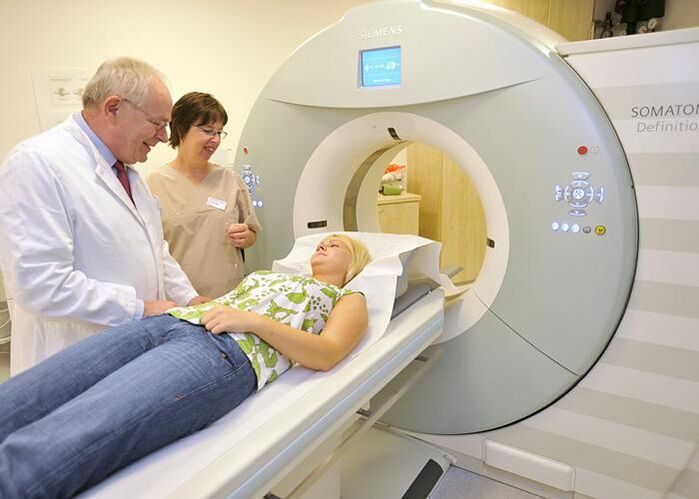
Treatment
Your doctor will tell you how to treat osteochondrosis of the cervical spine and not damage the body. Here are the basic rules and recommendations for treating this nasty disease, but the beginning of successful treatment is a visit to a neurologist. The treatment of osteochondrosis of the cervical spine is carried out using a whole series of methods. Among them:- drug treatment?
- physiotherapy?
- traditional medicine?
- exercises.
Osteochondrosis of the cervical spine is more dangerous, as important arteries that carry blood to the brain tissues pass through the vertebral processes in this area. Therefore, taking medication and fulfilling the doctor's prescriptions should be approached with every responsibility.
Drug treatment
How to treat cervical osteochondrosis using drugs? Drug treatment of the disease includes the following means:
- pain medications?
- anti-inflammatory?
- vitamins?
- chondroprotectors.

Non-steroidal anti-inflammatory drugs are designed to reduce inflammation, including Diclofenac, Ibuprofen, Piroxicam. Such funds are also used externally. These are various ointments and gels: "Diclofenac", etc. Of the vitamins, the most valuable maintenance vitamins for osteochondrosis are B vitamins, which can reduce tissue sensitivity and weaken the neurological manifestations of the disease.
Chondroprotectors
Formulated by pharmacologists for the restoration of cartilage tissue. There are two active ingredients that make up such drugs - glucosamine and chondroitin. Both compounds can be included in a preparation or used separately. Examples of chondroprotectants: glucosamine patches, chondroitin sulfate ointment, etc. These funds should be used for a long time, at least 3-6 months, otherwise you may not achieve the desired result.
Exclusion
In case of severe pain, injections of drugs directly at the site of injury help alleviate the patient's condition. This injection is called exclusion. A mixture of drugs is commonly used as a medicine. One of them has an analgesic effect, the other is designed to relieve inflammation. The exclusion can only be done by a specialized doctor, in no case do you do this procedure yourself! This can not only harm the patient's health, but also threaten his life. This injection is done in two ways:
- injection of a drug into the ligaments and tissues surrounding the joint.
- injection directly into the intervertebral disc.
Physiotherapy
Physiotherapy procedures are very effective in osteochondrosis of the cervix. They accelerate recovery, have a beneficial effect on the whole body as a whole. Before we talk about them, here are the contraindications for physiotherapy:- tumors, oncological diseases?
- blood diseases?
- acute dermatological diseases?
- taking medicines that can enhance the effect of physiotherapy.
How to treat cervical osteochondrosis using physiotherapy? In this respect, the use of many methods has a good result. For example, shock wave therapy is the application of acoustic waves to a lesion. Reduces inflammation, swelling, pain, stimulates collagen synthesis and improves tissue metabolism. Also used laser therapy, magnetotherapy, ultrasound therapy, vibration therapy. The effect on the sore throat with low voltage pulse currents or dynamic treatment reduces the severity of the pain. Additional methods of physiotherapy are ultraviolet radiation to the affected area and traction of the spine or abductor therapy.
Physiotherapy exercises
Exercise for cervical osteochondrosis allows you to achieve tangible results. It is important to apply only in the final stage of treatment, as active movements in the neck area are strictly forbidden in the first and intermediate stage. The exercise is performed with a cotton gauze collar worn on the neck area. Resistance exercises are performed with the help of a doctor who tries to tilt the patient's head with his palm, and in turn, tries to overcome the actions of the doctor. This strengthens the muscular corset of the neck. A head exercise is also helpful. As follows. The patient, lying on the couch, raises his head and holds it in this position for 5 seconds. This time it is 40-60 seconds if the pain and the neurological syndrome have already been overcome. Therapeutic gymnastics provides for the application of each exercise no more than 5 times in one approach.
Gymnastics for osteochondrosis of the cervical spine is designed for:
- improve blood supply to the affected area.
- to strengthen the muscles of the back and neck.
- reduction of the load on the vertebrae.
- normalization of joint mobility.
- Accelerates glucose metabolism for active nutrition of the intervertebral cartilage discs.
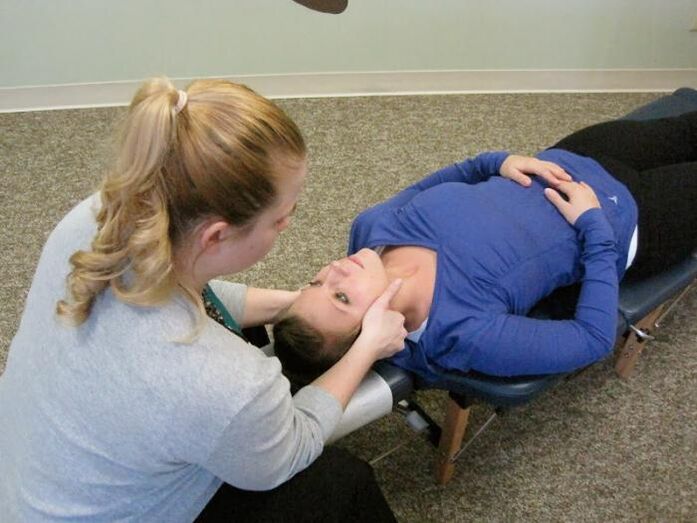
In a disease such as cervical osteochondrosis, massage is required. It refers to the methods of manual therapy and aims at the relaxation of the muscles, the improvement of the blood circulation and the lymphatic movement at the point of the injury.
Traditional medicine
Treatment of a disease such as osteochondrosis of the cervical spine, folk remedies are considered as an adjunct and in no case as the main treatment. The number of recipes that use different herbs and products is very large. They widely use products such as lemon, garlic, burdock or horseradish leaves (as a compress), dandelion root, St. John's wort. John's wort, yarrow, lavender and more. The patient himself is responsible for his health when he uses traditional medicine.

Nutritional possibilities
How to treat cervical osteochondrosis? This question is asked by many. But how to eat with this disease, what foods will be useful? Let's list them:
- dairy products?
- lean meat and fish?
- jelly meat?
- jam?
- jelly;
- fresh fruits and vegetables?
- sources of vitamin B - liver, nuts, brown rice, broccoli, buckwheat, brewer's yeast, green vegetables, kidneys.
- complex carbohydrates - wholemeal bread, cereals, vegetables
- vegetable fats - olive, sunflower oil, flaxseed.
Do not forget products that can be harmful in the treatment of osteochondrosis. Do not use too many sweets, roasts, alcohol, smoked meat and salty foods, spicy foods, animal fats, coffee and strong tea. Remove sugar, potatoes and white bread from the menu.
Prevention
Do not neglect your morning exercises, as well as stretching your neck during the working day. Helps improve blood circulation, thus ensuring the supply of nutrients to cartilage tissue and muscle relaxation. Go further - regular jogging, fitness classes are considered an important measure to prevent osteochondrosis. Being overweight often causes the disease to develop, so try to follow the arrow on the scales. Do not eat too much, do not use too high in calories, fatty and sugary foods. Eliminate all chronic infections in your body. Particular attention should be paid to the correct position of the body during sleep and rest - the neck muscles should not be compressed.
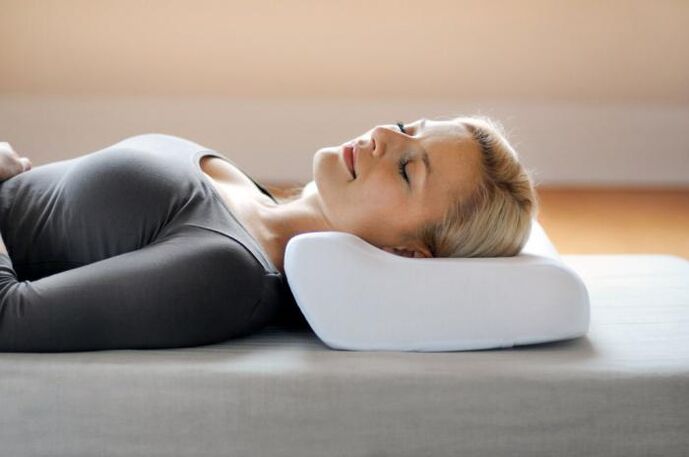
For example, every patient should have an orthopedic pillow for osteochondrosis of the cervical spine and its use is also useful in preventing the disease. Rest relaxes the neck muscles and the blood vessels do not face intense pressure

































